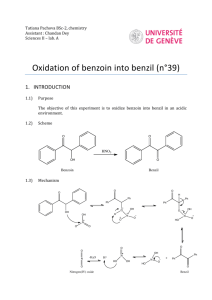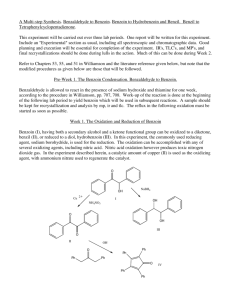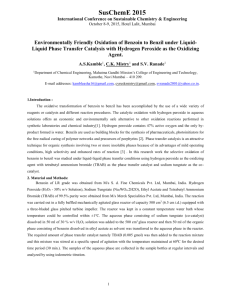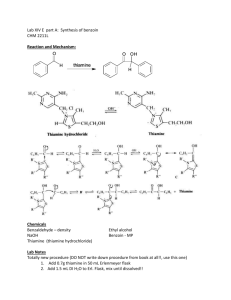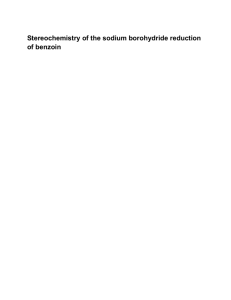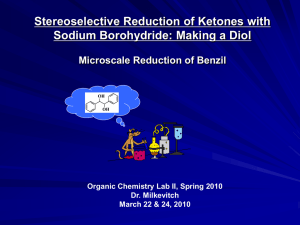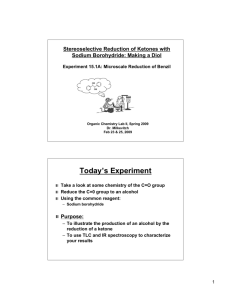Tetraphenylcyclopentadienone Synthesis: Lab Manual
advertisement
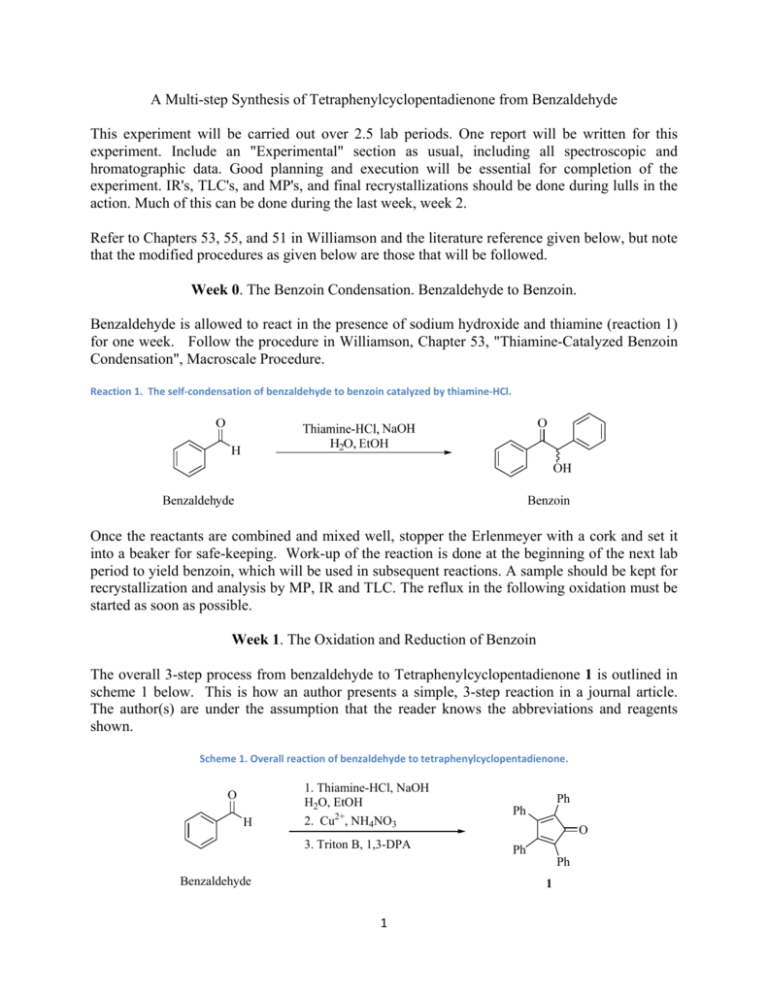
A Multi-step Synthesis of Tetraphenylcyclopentadienone from Benzaldehyde This experiment will be carried out over 2.5 lab periods. One report will be written for this experiment. Include an "Experimental" section as usual, including all spectroscopic and hromatographic data. Good planning and execution will be essential for completion of the experiment. IR's, TLC's, and MP's, and final recrystallizations should be done during lulls in the action. Much of this can be done during the last week, week 2. Refer to Chapters 53, 55, and 51 in Williamson and the literature reference given below, but note that the modified procedures as given below are those that will be followed. Week 0. The Benzoin Condensation. Benzaldehyde to Benzoin. Benzaldehyde is allowed to react in the presence of sodium hydroxide and thiamine (reaction 1) for one week. Follow the procedure in Williamson, Chapter 53, "Thiamine-Catalyzed Benzoin Condensation", Macroscale Procedure. Reaction 1. The self‐condensation of benzaldehyde to benzoin catalyzed by thiamine‐HCl. Once the reactants are combined and mixed well, stopper the Erlenmeyer with a cork and set it into a beaker for safe-keeping. Work-up of the reaction is done at the beginning of the next lab period to yield benzoin, which will be used in subsequent reactions. A sample should be kept for recrystallization and analysis by MP, IR and TLC. The reflux in the following oxidation must be started as soon as possible. Week 1. The Oxidation and Reduction of Benzoin The overall 3-step process from benzaldehyde to Tetraphenylcyclopentadienone 1 is outlined in scheme 1 below. This is how an author presents a simple, 3-step reaction in a journal article. The author(s) are under the assumption that the reader knows the abbreviations and reagents shown. Scheme 1. Overall reaction of benzaldehyde to tetraphenylcyclopentadienone. O H 1. Thiamine-HCl, NaOH H2O, EtOH 2. Cu2+, NH4NO3 Ph 3. Triton B, 1,3-DPA Ph Ph O Ph Benzaldehyde 1 1 Scheme 2 outlines the individual reactions. Benzoin 2, having both a secondary alcohol and a ketone functional group is oxidized to the diketone, benzil 3 (Scheme 2), or reduced to a diol, hydrobenzoin 4. In this experiment, the commonly used reducing agent, sodium borohydride, is used for the reduction. The oxidation takes place with any of several oxidizing agents, including nitric acid. Nitric acid oxidation however produces toxic nitrogen dioxide gas. In the experiment described herein, a catalytic amount of Cu2+ is used as the oxidizing agent in the presence of ammonium nitrate, which is used to regenerate the active Cu2+ catalyst. The desired product 1 is then generated when 3 is treated with 1,3-diphenylacetone in the presence of benzyltrimethylammonium hydroxide (Triton B). Scheme 2. Tetraphenylcyclopentadienone from benzoin via benzil. Both the oxidation and reduction will be carried out on the same day. The oxidation requires a 1.5 hr reflux period so that reaction should be set up first. While the oxidation is proceeding, the reduction will be carried out. It is important to plan well so that everything can be done in one lab period. Oxidation of Benzoin. Because the procedure for the oxidation will be taken from an article in the library (or possibly on the web) it is essential that you find the article and prepare the prelab outline well in advance of the lab. Find the journal article, "The Catalytic Oxidation of Benzoin to Benzil", J. Am. Chem. Soc. 1948, 70, 3666 and, using the procedure in that reference (small run), plan a synthesis of benzil starting with 0.0025 mol of benzoin, scaling down the quantities of all other reagents by the same factor. Note that in scaling down a reaction, reaction time remains the same. The reflux apparatus will be the 5 mL microscale round-bottomed (rb) flask and air-cooled condenser. Heat carefully on the sand bath, with swirling (not shaking) until the vigorous evolution of nitrogen subsides then adjust the heat for a gentle reflux. (On the small scale used here, nitrogen evolution may not be vigorous and in fact may not be noticed. Once the reactants are dissolved, assume nitrogen evolution is complete and proceed with the reflux.) While the 1.5 hour reflux is taking place, carry out the next reaction, "Reduction of Benzoin". Check the reflux occasionally to be sure it is refluxing at a good rate and solvent is not being lost to evaporation. After the 1.5 hr reflux, modify the procedure for the work-up as follows: cool the reaction mixture until the flask is just warm to the touch then add it to about 2.5 mL of ice-water, with stirring. Cool the mixture in an ice bath for 5 - 10 min and collect the product by suction filtration. Temporarily break the vacuum 2 by lifting the filter slightly off of the filter flask, cover the crystals with 2 mL of ice-cold rinse water, and immediately reattach the vacuum to remove most of the water. Allow the product to dry at least overnight, weigh it, calculate a % yield, obtain an IR spectrum (mull) and determine the MP. Save the product for tlc and a subsequent reaction. Reduction of Benzoin. In a 50 mL Erlenmeyer flask, dissolve 1.0 g of benzoin in 10 mL of ethanol (all of the benzoin may not dissolve - this is ok). Carefully add, in small portions, over 5 minutes, 0.20 g of sodium borohydride, with swirling. This reaction is exothermic and care must be taken to not add the borohydride too rapidly. After addition is complete, allow the reaction to proceed at room temperature for 20 min, with frequent swirling. While cooling in an ice bath, add 15 mL water, then 0.5 mL 6M HCl. Add another 5 mL of water and allow the mixture to stand for 20 min with frequent swirling. Collect the product by suction filtration and rinse with 50 mL of water. Recrystallize about 50 mg of the solid by dissolving it in 0.5 mL warm ethanol, adding 1 mL of warm water and allowing it to cool to rt then in an ice bath for at least 45 minutes, an hour if time allows. While this is crystallizing, work up the oxidation reaction, which should be finished refluxing at this point. Once the crystallization of hydrobenzoin is complete, separate the crystals from the solvent, rinse, and allow them to dry at least overnight. A MP and IR spectrum (mull) will be determined and a TLC run. On the strereochemistry of the reduction. The reduction of benzoin to hydrobenzoin can lead to different stereoisomers – a meso compound and a pair of enantiomers. Using the MP of the product, decide which, if any, isomer predominates in the reduction reaction. In the discussion, explain why one isomer might predominate. (Hint: the hydroxyl group in benzoin can coordinate with the borohydride, thus causing a hydride to add to the carbonyl from the side on which the hydroxyl group is situated. Using models and considering the stability of the benzoin conformers, try to predict on which side of the carbonyl the hydride will be delivered.) Figure 1. Hydrobenzoin showing 'wavy' bonds indicating a mixture of 'dashes' and 'wedges.' ' Week 2. Prepare Tetraphenylcyclopentadienone and finish up. This week you will prepare tetraphenylcyclopentadienone, recrystallize it and determine its MP. You will also collect the following data for the three previously synthesized compounds, benzoin, hydrobenzoin, and benzil: MP's (crude and recrystallized), IR spectra (as mulls), and tlc data. Synthesis of Tetraphenylcyclopentadienone. Using the benzil prepared during the previous lab period, prepare tetraphenylcyclopentadienone according to the procedure given in Williamson, Chapter 51 (Exp. 1, Microscale). Note the following changes and suggestions. Be very careful to not break the thermometer or poke a hole through the bottom of the reaction tube. USE CARE WHEN WORKING WITH TRITON B – SEE SAFETY SECTION BELOW. To measure the 0.20 mL of Triton B solution, use the syringe with the blunt-end needle from your kit. Draw the 0.2 mL into 3 the syringe, then place the syringe into a 50 mL Erlenmeyer flask, needle tip down, until you are ready to use the Triton B. Reaction temperature is critical; when the sol'n has reached 100°, remove the tube from the sand bath and if necessary allow it to cool to 100°. Then add the Triton B and stir well. Maintain the temperature at 90-100° until crystals begin to appear, then continue heating at this temperature for a minute longer. In the hood, rinse the syringe with a little acetone and add the rinse to the Triton B waste container. Then rinse out the syringe with water at your wash sink. If the crystals are too small to separate from the solution by the pipet method, collect them on the small Hirsch funnel. After rinsing the crystals with cold methanol, save a small amount of crude material for a MP (to be taken later), and recrystallize the remainder. CHANGE: use as a recrystallization solvent, a 1:1 meso - isomer one isomer of an enantiomeric pair mixture of 95% ethanol and toluene (approximately 1.2 mL/50 mg product), not triethylene glycol as stated in the book. The crystals dissolve slowly so let them heat for a minute between additions of solvent. Otherwise, too much solvent may be added resulting in a low or zero yield of crystals (you can always boil off excess solvent if you've added too much). Allow the crystals to dry at least overnight. Weigh the product, determine the % yield, and take the MP of crude and recrystallized material. Waste Disposal: CHANGE: Place all filtrate and methanol rinsings from the initial reaction into the container labelled "TRITON B Waste". Solvent and rinsings from the recrystallization should be placed into the "NONHALOGENATED solvent waste" container. Eventually, when you are finished with your product and your TA no longer needs to see it, place it into the container labelled "tetraphenylcyclopentadienone" - do not include filter paper. We may actually put your product to use in a research lab, thus recycling it and eliminating the need for disposal. Safety. Triton B is toxic and is as caustic as sodium hydroxide. Keep it off of your skin. If you become accidentally contaminated, wash the affected area immediately with water. Clean up all spills immediately or others may become contaminated. Postlab Questions for the Multistep Synthesis Report. 1. Draw structures for the meso compound and enantiomers of hydrobenzoin. Your structures should include an explanation of why the meso is meso and why the enantiomers are enantiomers. 2. Write a mechanism for every reaction in the sequence, including the benzaldehyde step. You may omit the Cu2+ oxidation. 3. A compound that contains a highly conjugated system of pi electrons absorbs energy in the visible region of the electromagnetic spectrum, thus making the compound appear colored. Using resonance structures discuss why tetraphenylcyclopentadienone is highly colored. 4. Why is Triton B rather than sodium hydroxide used as a base? 5. Interpret the IR spectra of benzoin, hydrobenzoin, and benzil and discuss how IR is especially helpful in following these transformations. 6. In the oxidation reaction, nitrogen gas is evolved. Show a mechanism how the N2(g) is formed. (Hint: note that in the reaction, nitrate is reduced to nitrite. Also, consider Wade, section 19-17.) 4

